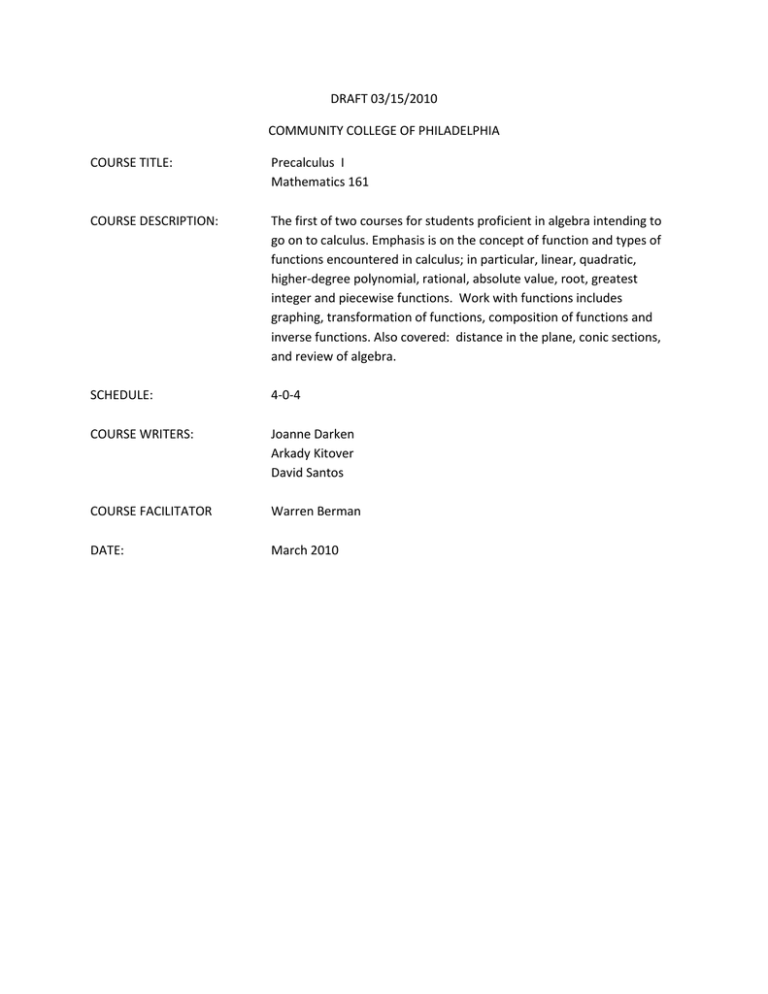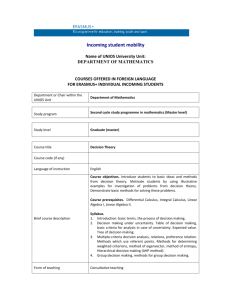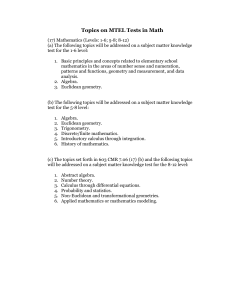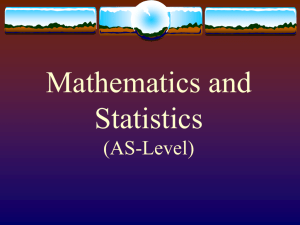DRAFT 03/15/2010 COMMUNITY COLLEGE OF PHILADELPHIA
advertisement

DRAFT 03/15/2010 COMMUNITY COLLEGE OF PHILADELPHIA COURSE TITLE: Precalculus I Mathematics 161 COURSE DESCRIPTION: The first of two courses for students proficient in algebra intending to go on to calculus. Emphasis is on the concept of function and types of functions encountered in calculus; in particular, linear, quadratic, higher-degree polynomial, rational, absolute value, root, greatest integer and piecewise functions. Work with functions includes graphing, transformation of functions, composition of functions and inverse functions. Also covered: distance in the plane, conic sections, and review of algebra. SCHEDULE: 4-0-4 COURSE WRITERS: Joanne Darken Arkady Kitover David Santos COURSE FACILITATOR Warren Berman DATE: March 2010 Precalculus I Mathematics 161 A. Course Description The course develops the concept of function, which is crucial to the study of calculus. After introducing this concept it focuses on types of functions, operations with functions, and graphing functions. Types of functions considered are linear, quadratic, higher-degree polynomial, rational, absolute value, root, greatest integer and piecewise functions. The operations are arithmetic of functions, composition, inversion and transformations of functions. Analysis of graphs includes consideration of local maxima and minima, intervals of increase and decrease, and poles. Related topics covered are distances in the plane, conic sections, basics of complex numbers, and some review of algebra. B. Rationale This course is intended primarily as preparation for calculus. It also satisfies a mathematics requirement for some programs that do not require calculus. (These programs are Accounting, Business, Communication Arts, and several Hospitality Tech options. Also, Architecture and Computer Science require Math 162, for which Math 161 is a prerequisite. Heads of these programs have been consulted about an additional hour for Math 161: reactions range from neutral to enthusiastic.) Because of the mixed population it is particularly desirable that the course be intellectually stimulating and coherent as a terminal course, besides continuing the education and maintaining the interest of students who intend to go further in mathematics. The course can also be a turning point for talented students who have not previously considered pursuing the subject further. This level of mathematics course (frequently called college algebra) has been a focus of national attention (e.g., the National Science Foundation) in recent years as a recruiting ground for STEM (science, technology, engineering, mathematics) careers, the interest springing from the concern that the nation is not producing enough practitioners in these fields to meet its needs and replace those retiring. From the point of view of the individual student, it is a gateway to some very interesting and well-paid careers. Math 161 is currently a 3-hour, 3-credit course, and the additional hour we propose would provide time to promote problem solving, deepen understanding, and perhaps demonstrate applications. Also, it would provide more opportunity to consolidate background. Many faculty in the Mathematics Department have experimented with pedagogical methods and other tools to increase pass rates, and have been frustrated by the need for more time. A number of area institutions, including Temple University, our chief transfer institution, have added an hour to their comparable courses. Institutions elsewhere have done the same with this course or lowerlevel ones and report good results. Our institution had a four-hour version of this course for several years in the mid-nineties , in the MACMATC project, under the auspices of an NSF grant, and produced significantly higher pass rates, with comparable success rates in the subsequent course. (That project had other helpful features, some of which could be used again, though some probably not because of expense (most prominently small class size). However we now have new tools: materials and interactive sites on the web, which some instructors have already used to advantage in this and other courses.( See appendix for more information on the MACMATC project here and details about other schools.) C. Course Goals/Learning Objectives At the end of the course a student will be able to: Identify the type of a number (integer, rational, irrational, real, complex) Write, read and speak all terminology correctly Explain what a function is and what is meant by the domain and range of a function Evaluate a function at a point given its definition Recognize whether or not a rule, table or graph represents a function Recognize the type of a function of any type studied from its graph or formula Read and create graphs of functions of the types studied Perform the algebraic manipulations necessary to work with functions Graph a transformation of a function from the graph of the function Add, subtract, multiply, divide and compose functions, and find their inverses where possible Determine the domain and range of functions of the types studied Perform and recognize transformations of functions: translation, reflections, stretchings Determine symmetries in functions and relations Know the domain and range of a linear function Recognize whether two lines are parallel or perpendicular from their equations Recognize whether a line is vertical or horizontal from its equation. Find the slope of a line from two points on it, its equation, its graph or other defining properties Find the equation of a line from two points on it, its slope, or its graph Recognize and utilize the forms of a quadratic function Determine the vertex, intercept(s) and concavity of a quadratic function from its formula or graph Apply the quadratic formula to find the zeros of a quadratic function Use the discriminant of a quadratic to determine the number of its real roots Recognize a function quadratic in type Recognize a power function from a sketch or formula, and the basic type of the power function Recognize a polynomial function from a sketch or formula, and the basic type of the power function Understand the relation between zeros and factors of a polynomial function Analyze the behavior of a rational function at its poles Find the vertical and horizontal asymptotes of a rational function Characteristics of functions: injectivity, monotonicity Identify intervals of increase and decrease of a function from its graph Understand the concept of local extrema and determine them from a graph Compute distances in the plane Recognize the type of a conic section from its graph or formula, and find foci, vertices and directrices as appropriate Do elementary computations with complex numbers Appreciate the continuity of the topics in the course Solve problems involving synthesis of concepts learned Do elementary applications D. Planned sequence of activities The sequence of topics may vary among instructors; for example, some do algebra review at the beginning while others work it in throughout the course. Similarly, some may discuss distance and use conic sections as a tool for reinforcing algebra near the beginning of the course, whereas others discuss this topic near the end. The definition of function comes early in the course in every section. E. Student Learning Activities 1) Lecture, question-and-answer: There will be lecturing and question-and-answer in every section 2) Technology: There will be some variation among instructors in the use of technology: 3) Web resources: Some instructors have been using publishers’ websites to advantage for homework and/or class assignments. It can be arranged that a student gets more than one try at an exercise: the instant feedback about the answer and the occasion for reflection on one’s mistakes is valuable. The publishers make the problems “algorithmic:” that is, different students get different numbers to work with. This makes copying another student’s answers useless, but still allows students to collaborate on an abstract level . It is necessary to take some time (about an hour and a half) in class to orient students to the site (without this incapacitating frustration can result) and some time to deal with occasional glitches during the semester (about an hour or two total on an individual level, while other students work problems). There are also resources on the web such as Alice, which is used to create games that teach concepts. It has been used for computer science classes here and might be adapted for mathematics. Maple: This mathematics software has already been used by some instructors in mathematics courses here, and it is used at Penn and Drexel. It takes 2 to 3 hours to orient calculus students to the software in the computer lab, and more time during the course to help them correct mistakes (usually typos). For precalculus students orientation takes longer, perhaps 3 to 4 hours, and correcting mistakes at least as much time. Clickers: These devices enable an instructor to ask True-False or short-answer questions and get immediate feedback from students in a class, each student having a clicker with which to respond. The breakdown of results appears on a screen as soon as the results are in. This is a quick and easy way for an instructor to find out how well the class understands the lecture, and provides interest and stimulation for students, as well as timely correction of error. Clickers are, in the opinion of many, most useful for large lectures, but have been used at this institution (though perhaps not in the Mathematics Department). Even in a small class they provide shyer students with a safe way to participate. Orientation time is brief, though set-up may eat into class time. For an instructor who prefers lecture, clickers provide an efficient way of promoting active student involvement and getting quick feedback. Calculators: These have been used widely in the department (though their use is banned on the departmental final in developmental courses out of concern that their use can interfere with development of basic arithmetic skills, though even in these courses some faculty have students use them in class to work on more interesting and complex problems). In higher level courses they are often used to expedite computation. Orientation time: short. Graphing calculators: Because of the graphing feature and other sophisticated aspects, these are useful in the way basic calculators are but in many more situations. 4) Group work: Working in a group of three or four can be highly beneficial since it gives students a venue for discussion that minimizes the fear of embarrassment that full class discussion or asking a question of the instructor can pose. It gives students a chance that they might otherwise not have to share ideas, find study mates, and, importantly, learn to be more active and less passive in their education. It gives instructors a chance to listen to student discussion and thus hear in a comparatively informal setting how they are thinking, and to answer questions more efficiently, by requiring students to discuss with others in their group first (and not to take up the entire class’s time if not many students have that question). Since not all instructors are comfortable with group work in class, it will not occur in every section, but many faculty use this method already to the extent possible within the current time constraints, and would like to use it more. 5) Homework: Homework, on the web or not, reinforces concepts and methods and is a traditional staple for learning. If class time is used for more challenging problems, them homework can expand on those problems as well as provide routine drill and reinforcement. 6) Tests can of course be a learning experience. They serve as a motivation to learn, of course, and to focus on what is most important. A good test includes questions that require some synthesis of material learned, and thus promote learning. F. Required Texts Text selection is at the discretion of the instructor. The principal criterion for selection of a text is that it covers the material as described in this document. The current departmentally recommended text is: Stewart, James, et al., Precalculus: Mathematics for Calculus, 5th ed., Brooks/Cole Pub. Co., 2006. This text has an associated interactive website. Recent text selection in this and other courses takes web resources into consideration. G. Library Resources and Bibliography In line with the ambition that this course encourage capable students to pursue mathematics and consider a careers in the mathematical sciences, we recommend that the library stock the following books and journal. (MAA = Mathematical Association of America) The Alberta High School Math Competitions 1957-2006, ed. Andy Liu, MAA 2009 She Does Math! Ed. Marla Parker, MAA 1995, ed. Amy Shell-Gerlach, MAA 2007 Mathematics in Historical Context, by Jeff Suzuki, MAA 2009 Problems from Murray Klamkin, ed. Andy Liu and Bruce Shaw, MAA 2002 Sherlock Holmes in Babylon and Other Tales of Mathematical History, ed. Marlow Anderson , MAA, 2004 (Already in the library) Victor Katz and Robin Wilson< MAA 2004 Creative Mathematics, by H. S. Wall, MAA 2009 Aha! Solutions, by Martin Erickson, MAA 2009 (Already in the library) Sink or Float? Thought Problems in Math and Physics, by Keith Kendig, MAA 2008 101 Careers in Mathematics, ed. Andrew Sterrett , MAA 2003 Math Horizons (MAA journal) H. Computer Literacy and Technological Resources This course does not include a specific computer literacy or technology requirement. However, a variety of technology has been used by instructors of the course (as described in Section E) and with additional time in the course it is anticipated that usage will increase. I. Student Assessment Students are evaluated on how well they communicate their understanding of the principles and methods of the mathematics presented in the course. Understanding is assessed on the basis of tests and sometimes class work and/or homework, at the discretion of the instructor. A typical grading scheme is: Three tests during the semester @ 20% each Quizzes, homework or class work Comprehensive final exam Total 60% 10% 30% 100% The percentages assigned to each category may vary by instructor. A: 90%-100% B: 80%-89% C:70%-79% D:60%-69% F: Below 60% J. Course Assessment Course assessment will address the following issues 1. Does the course prepare students thoroughly for calculus? 2. Are the instructional methods of the course appropriate with regard to new developments in pedagogy and technology? 3. Does the course increase students’ interest in mathematics? Methods of course assessment include: 1. Faculty discussion of teaching strategies and experiences 2. Periodic review of the goals, texts and methods of the course by the Precalculus Committee of the Mathematics Department 3. Participation in existing evaluation processes such as academic audits 4. Statistical analysis of student date to determine student success in calculus, at this institution and elsewhere. 5. Evaluation by faculty teaching the course. (See Section L.) Revisions of topics, methods of presentation and student assessment will be revised as appropriate based on these assessments. K. Sample syllabus L. Faculty Course Evaluation Form M. Appendices




